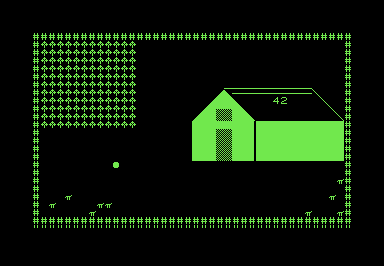CURSOR #18 – March 1980

COVER
Author: Peter Stearns
Original file name: COVER18
PRG file: cover18.prg
This month's cover, called "Stacking Blocks", is an animation that places PETSCII blocks one at a time in a pattern that resembles the Q*Bert playfield. When the pyramid is complete, the PET removes the blocks and then restacks them again in an endless cycle. The animation makes good use of the PETSCII graphics characters to give each each face of every block its own individual shading.
Pressing SPACE takes you to the table of contents for the issue.

DROMEDA!
Author: James Carr
Original file name: DROMEDA!
PRG file: dromeda.prg
DROMEDA! is an animation that appears to draw inspiration from Michael
Chrichton's novel
The Andromeda Strain.
A mysterious object plummets from the sky and crashes into a quiet city street—I won't spoil
what happens next! Carr's superlative PETSCII work effectively showcases some of the cool things you
can draw with character graphics. I enjoyed watching this one but felt it was over too quickly.
Leave 'em wanting more—that's good show business.

JOUST
Author: Brian Sawyer
Original file name: JOUST
PRG file: joust.prg
JOUST is not the familiar
arcade game
with flying ostriches and buzzards flapping around platforms, but a more traditional simulation
of two knights on horseback trying to unseat each other with lances. (The arcade game wasn't released
until 1982, and this CURSOR tape was issued in 1980.)
As the horses (slowly) rush towards each other, the two players adjust the vertical positions
of their lances and shields from opposite ends of the keyboard, with the left player
using Q / Z / E / C and the right player using
7 / 1 / 9 / 3 on the numeric keypad. You'd
need to play this game on a machine with a full keyboard; the right-side player would be at
a serious disadvantage if they had to use the top-row numbers to make their adjustments. While
I don't see JOUST getting a lot of playtime today, it is exactly the sort of
game that we would have played over and over at school when I was a kid.

WEATHER
Author: Randall Lockwood
Original file name: WEATHER
PRG file: weather.prg
WEATHER is a simple BASIC program that asks the user for two recent barometric
readings along with the current wind speed, cloud cover, and temperature. From this data, the program
attempts to come up with a short-range forecast. CURSOR makes "absolutely no claims that
it is accurate or correct," so I'm guessing they wouldn't recommend you use this program when planning
a picnic. You'll likely have to do a bit of unit conversion: instead of the metric kiloPascals (kPa),
the program expects barometric pressure to be measured in inches of mercury (inHg).
Now, skeptics might argue that five data points is not nearly enough weather data to generate
a reliable prediction but I can put those concerns to rest. I subjected WEATHER to
a rigourous test, entering my local current condtions when prompted. The PET predicted that the weather
wasn't going to change much
over the next 6 to 24 hours. To my amazement, the weather did not change at all—which
technically counts as a 100% success rate for this software.

HIRES
Author: Dave Dixon
Original file name: HI-RES
PRG file: hires.prg
HI-RES uses clever timing tricks to create a small pseudo-high-resolution region
measuring 9x5 character cells at the top of the screen. The program changes the character in every
cell before the PET draws each scan line, so for example, you could have the top half of the letter
H combined with the bottom half of the number 8, or any other arbitrary
combination of characters in a given cell. In this way, it becomes possible to place any pattern of
dots in the hi-res region, provided that pattern of dots is present in a byte of character ROM at
the correct horizontal line within some character glyph.
One of these days, I'll have to pick apart this program to see how the timing works. Unlike the
64, the PET does not have raster interrupts, so how do we know what scan line we're on? I'm also
not sure about the compatibility on various models of PET. Under emulation, HI-RES works
on the emulated 2001 but not the 4016. I wouldn't expect this program to work on the 80-column
machines (real or emulated) either.
I was going to make some hi-res graphics of my own using this program but it's hard to get any specific image to work. I thought about drawing some classic pixel art like the alien ships from space invaders but because not every dot pattern is represented on every scan line in the PET's character set, it's not always possible to create the image you want. It's also time-consuming to sift through character ROM to find suitable dot patterns. After about an hour of effort, I did manage to create a graph of a sine wave.

SHEEP
Author: Peter Stearns
Original file name: SHEEP
PRG file: sheep.prg
In SHEEP you control a sheepdog (named "Shep"), trying to herd a bunch of sheep
into a barn. The use of the π character for the sheep was an inspired choice—when
I was young, I knew nothing about the Greek alphabet or the mathematical constant pi but I did
think that the character resembled a sheep or a small dog. The sheep are hard to control; they are
afraid of your dog and will sometimes dart clear across the screen when you get too close to them. I was
never able to figure out how to get the sheep into the barn, although I did manage to get
one of the sheep
stuck on the roof.
